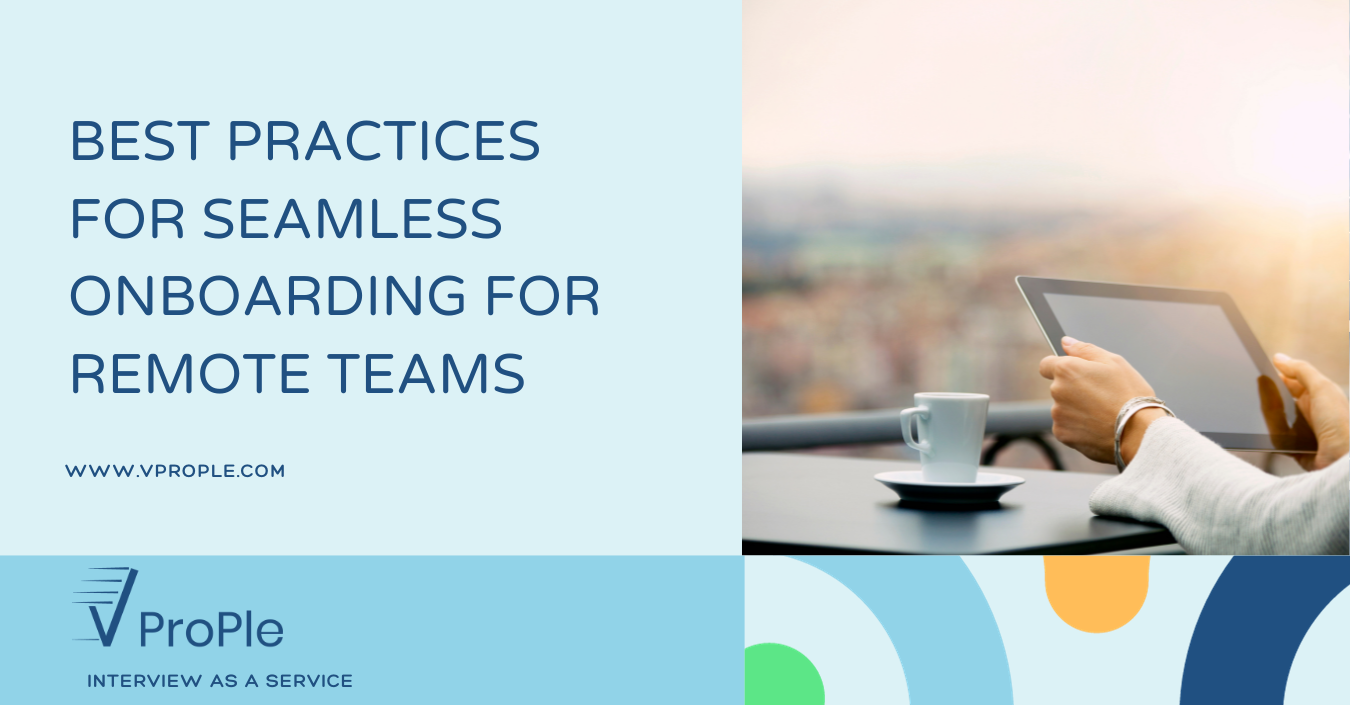This website use cookies to help you have a superior and more relevant browsing experience on the website.
BEST PRACTICES FOR SEAMLESS ONBOARDING FOR REMOTE TEAMS
-
21/10/2023

Hiring is an important part of a company’s growth, whether by yourself or by outsourcing the interview services and once it’s done, the new employees must get properly introduced to the unique work culture that every organization carries within itself. This part of the process is known as onboarding. This is where new team members of a department inside the organization get integrated with the existing team whilst also getting familiar with the operations and structure of the organization itself.
So, from the employer’s side, they must execute this process very effectively as it helps to build a foundation for a strong retention rate amongst new employees that will eventually help the overall productivity & brand image as well.
In this day and age of the post-pandemic era, the Work From Home (WFH) model still lives up to its hype for many companies. This is primarily because it saves the costs of owning or renting a workspace, cuts off the time taken to arrange it, and saves energy that would otherwise go into maintaining it. For the employees, they save a lot of time and energy that is otherwise consumed commuting from home to office.
This has led employers to adopt online interview assessments as well. With the work-from-home model, it is often not feasible to proceed with onboarding physically. That’s where remote onboarding comes in. This blog will take you through a lot more about onboarding for remote teams and how you can elevate the quality of the remote onboarding experience for new employees.
What is remote onboarding?
Remote onboarding is the process of carrying out onboarding via technology. After hiring new employees either by yourself or by outsourcing technical interview services, a fully successful process of physical onboarding may take up to 2 weeks with the beginning of professional training from the third week onwards. In the case of remote onboarding, the process can be wrapped in a shorter period of time.
Requirements to complete onboarding for remote teams
There are 3 kinds of requirements to complete onboarding at both physical and virtual workspace, they are organizational requirements, technical requirements, and social requirements. A good onboarding experience involves catering to all three requirements. Let’s learn about them more elaborately.
-
Organizational Requirements: Providing access to information through handbooks or documentation about the various structural facilities present in the office. In terms of remote onboarding, the organization is responsible for guiding about their virtual office platform.
-
Technical Requirements: This involves providing new hires with tools that are to be used in their work profile and motivating them to get familiar with the tools as soon as possible. This helps the employees to start getting productive in a new space on time, therefore creating genuine empowerment within them.
-
Social Requirements: There are a couple of ways in which you can fulfill social requirements and each one is necessary on its own. A Singular Point of Contact (SPOC) or an onboarding buddy from the organization is important to set expectations on how to build good relationships with old team members. Also, there must be opportunities planned out for informal interactions between new and existing employees.
Why consider onboarding of remote teams?
Multiple organizations have found remote onboarding very important for a multitude of reasons. As stated before, remote onboarding assures better team member retention and promises more productivity. Other reasons include-
-
Flexibility: Remote onboarding helps companies hire talent from anywhere in the world, either by themselves or by outsourcing technical interview services, especially if the location of their physical workspace is in a distant region from the candidate’s residence. This expands the number of potential candidates and also promotes diverse representation in the corporation.
-
Cost-Efficiency: Just like the benefits of operating in a work-from-home model as discussed before, onboarding also eliminates the need for physical office space, travel, and even relocation expenses for new hires.
-
Safety: In pandemic-like situations, remote onboarding ensures the safety of employees by cutting down on physical interaction.
-
Scalability: Remote onboarding advances scaling immediately to accommodate a growing workforce with infrastructural limitations.
-
Technology Integration: Remote onboarding encourages using technology with the latest digital tools for training and communication, therefore promoting tech-savviness among new hires.
-
Competitive Advantage: Companies that excel in remote onboarding gain a competitive edge by attracting qualified professionals because it provides them the freedom to work from the confines of their places, especially when they are looking for flexible arrangements.
Best Practices for Onboarding Remote Teams
To help you pull off a great, remote onboarding experience for the new employees we present you with some useful practices that can streamline the entire process much more efficiently.
-
-
Curate a detailed onboarding plan: It is a must to create an extensive onboarding plan for clarity in the process, to achieve onboarding goals, and to successfully set expectations for the employees without any communication issues.
-
-
Have an experienced mentor: The aforementioned onboarding buddy or the SPOC must have sufficient knowledge of the role they are in. They should also be thorough with the rules or policies that need to be explained to the new employees.
-
Keep checking regularly: It is important to realize that doubt-clearance in onboarding is not a one-and-done process and therefore, one needs to stay in contact with new employees at all times to clear their queries apart from the work, even when they are past their probationary period. Hence, it is important to establish an active communication channel between both the employee and the employer.
-
Help in setting an ideal workspace at home: This practice can be applied in various ways, you can send over the required furniture or equipment needed by the employee directly to their residence, or you might provide some allowance to aid them in setting up their home office.
-
Encourage open communication: Create opportunities where new employees can feel comfortable in their unique way of expressing themselves through their ideas and concerns. Adjust your approach accordingly based on the different personalities of all the new hires. Seek feedback for improvement wherever possible and be resource-ready with all tools that can help the new hires adapt to a new work environment successfully.
The journey of onboarding remote teams is the way for modern organizations to upgrade to a more adaptable and resilient version. As we find our way through the evolving landscape of work, it is evident that remote onboarding is not just a practical solution, but is also a strategic imperative. By using best practices for remote onboarding, such as detailed planning, hiring experienced mentors, providing consistent support, promoting open communication, etc., companies can ignite a sense of belonging and empowerment for the new team members.
Onboarding for remote employees is not merely a response to external challenges, such as the continuation of work life even during COVID-19. But it is also a forward-looking strategy that unlocks the great potential of the global talent pool whilst reducing costs and promoting technological proficiency. In doing so, organizations also gain a competitive advantage that attracts qualified professionals seeking flexibility and innovation.
Ultimately, onboarding for remote teams embodies the spirit of progress and inclusivity. It’s evident of the immeasurable human capacity to adapt, connect, and thrive faster in an ever-changing world, proving that even in a virtual environment, the foundations of strong teams are completely built on the human spirit to support, share, and empathize.


